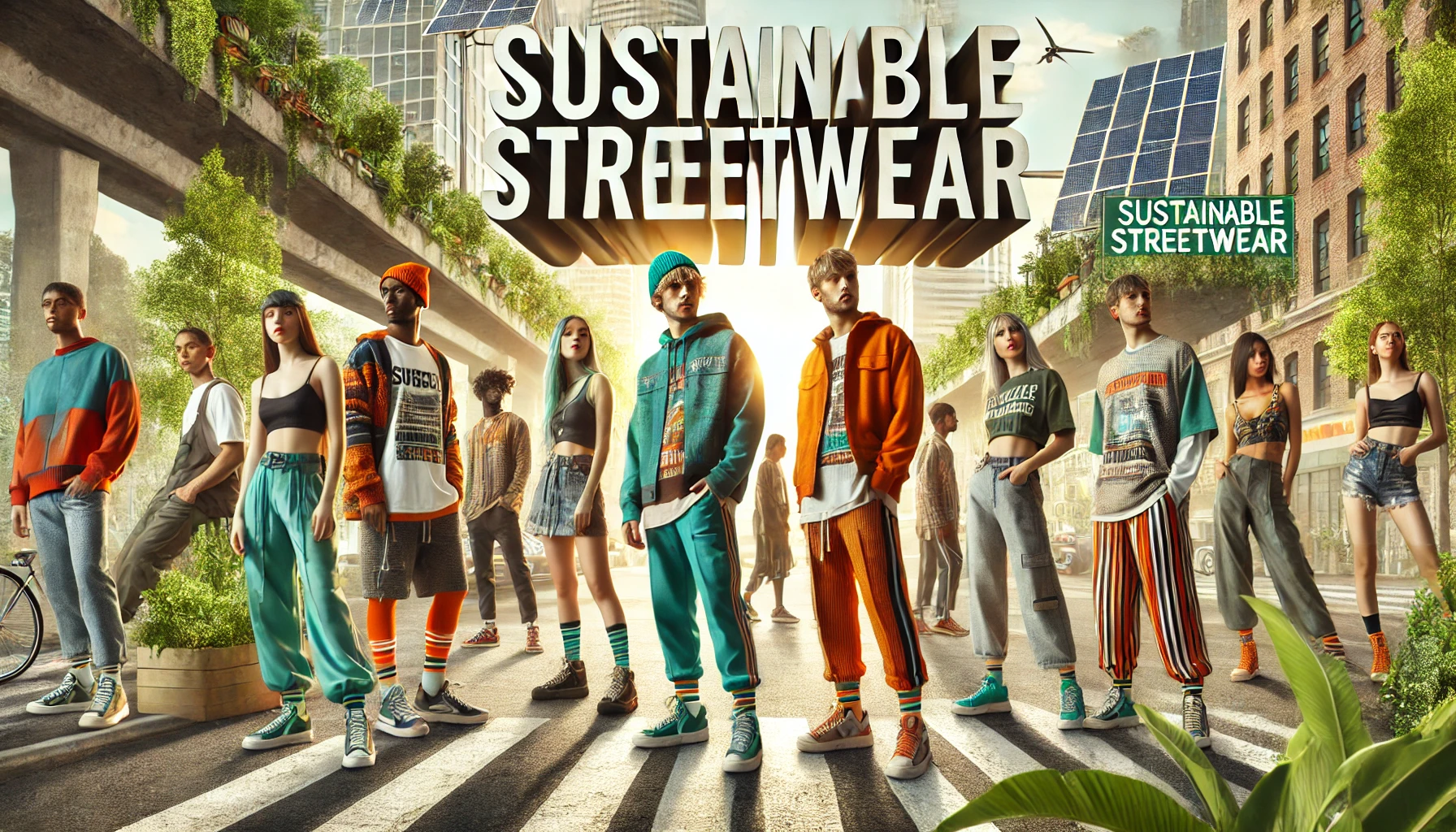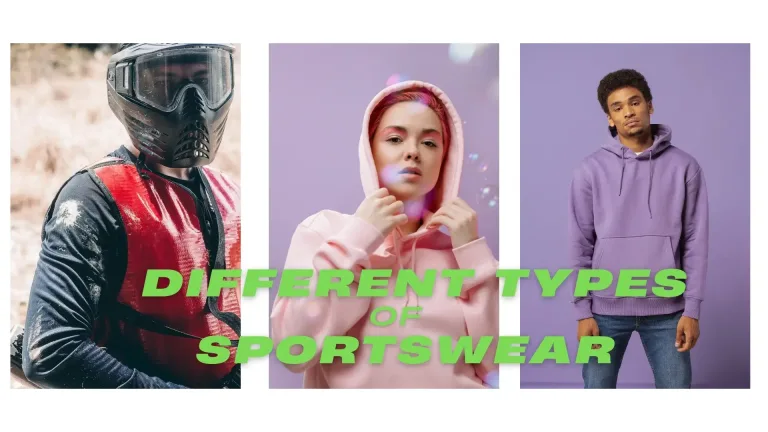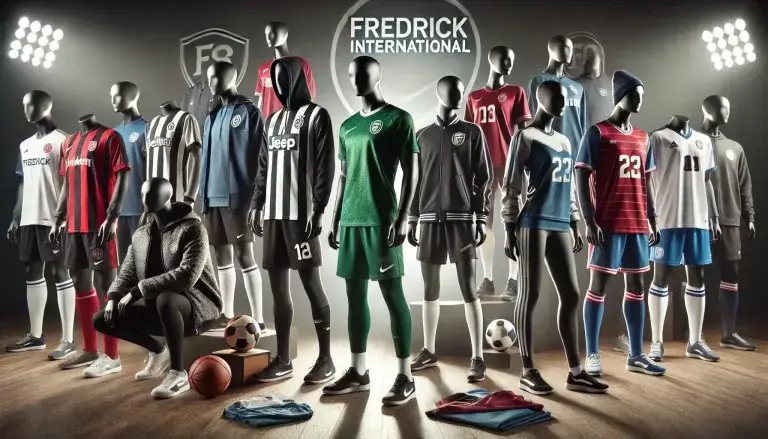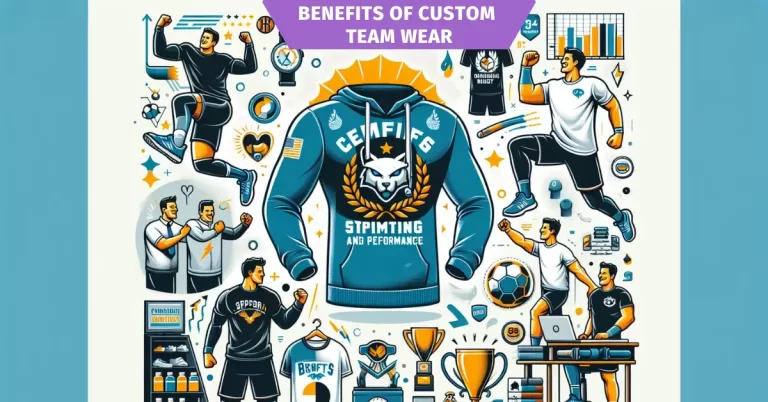Sustainable Streetwear: The Future of Fashion
Find sustainable streetwear, a movement revolutionizing fashion with eco-friendly practices, ethical production, and innovative designs.
Introduction to Sustainable Streetwear
Sustainable streetwear is a dynamic and forward-thinking fashion industry segment that produces stylish clothing with minimal environmental impact. This movement emphasizes ethical production, eco-friendly materials, and practices that reduce waste and pollution.
With the growing awareness of climate change and the impact of fast fashion, sustainable streetwear is gaining momentum as consumers seek alternatives that align with their values.
History of Streetwear
Streetwear originated in the 1980s, drawing inspiration from the skateboarding and hip-hop cultures. Initially, it was characterized by its casual, comfortable clothing and bold graphics. Pioneering brands like Stüssy and Supreme played significant roles in shaping streetwear, blending music, art, and youth culture elements.
Over the decades, streetwear has evolved into a global phenomenon, influencing mainstream fashion and fostering a unique community spirit.
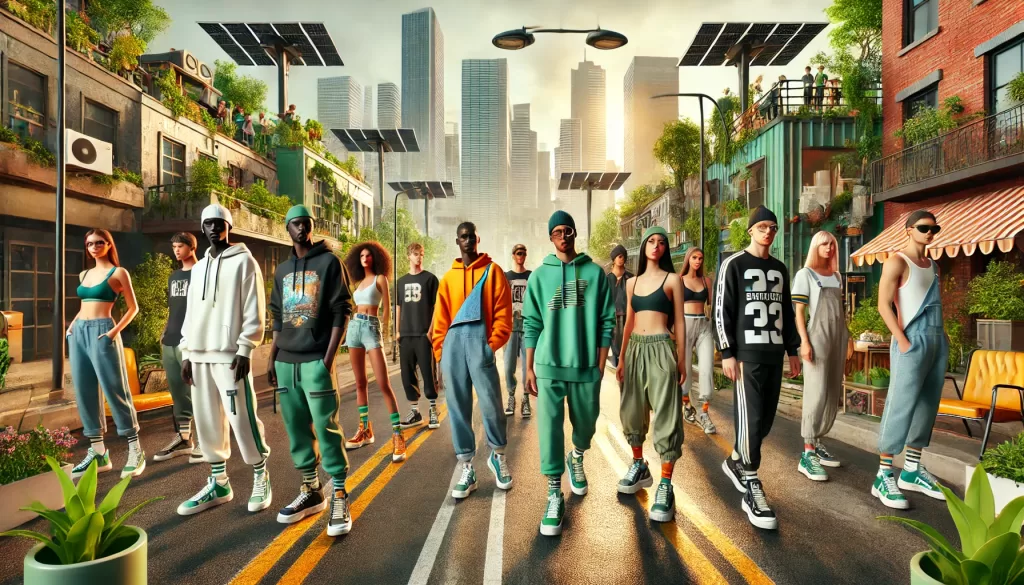
The Rise of Sustainability in Fashion
In recent years, the fashion industry has significantly shifted towards sustainability. This change is driven by increasing consumer demand for environmentally friendly products and greater brand transparency. Key milestones include the rise of ethical fashion movements, the introduction of eco-friendly fabrics, and adopting sustainable practices by major fashion houses.
Fundamental Principles of Sustainable Streetwear
- Ethical Production: Ensuring fair wages and safe working conditions for all workers involved in the production process.
- Eco-Friendly Materials: Utilizing materials with less environmental impact, such as organic cotton and recycled polyester.
- Waste Reduction: Implementing practices that minimize waste, such as using leftover fabric scraps and designing for longevity.
Eco-Friendly Materials in Streetwear
- Organic Cotton: Grown without harmful pesticides and fertilizers, organic cotton is a sustainable alternative to conventional cotton.
- Recycled Polyester: Made from recycled plastic bottles, recycled polyester helps reduce plastic waste and energy consumption.
- Hemp: A highly sustainable crop that requires minimal water and pesticides, hemp is durable and versatile.
- Bamboo Fabric: Known for its softness and breathability, it is produced from fast-growing bamboo plants.
Innovative Sustainable Fabrics
- Tencel: Derived from sustainably harvested wood pulp, Tencel is biodegradable and requires less water and energy.
- Econyl: A regenerated nylon made from recycled ocean plastic and industrial waste, Econyl is used in swimwear and activewear.
- Piñatex: An innovative leather alternative made from pineapple leaf fibers, Piñatex is both sustainable and cruelty-free.
- Mushroom Leather: Made from mycelium, the root structure of mushrooms, this biodegradable material is an eco-friendly alternative to animal leather.
Brands Leading the Way in Sustainable Streetwear
- Patagonia: Known for its commitment to environmental activism and sustainable practices, Patagonia offers a range of eco-friendly outdoor apparel.
- Veja: This sneaker brand uses organic cotton, wild rubber, and recycled materials to create stylish and sustainable footwear.
- Stella McCartney: A pioneer in sustainable luxury fashion, Stella McCartney’s collections are accessible from animal products and feature innovative eco-materials.
- Allbirds: Famous for its comfortable and sustainable shoes, Allbirds uses materials like merino wool and eucalyptus fiber.
- Reformation: A leader in sustainable fashion, Reformation focuses on reducing waste, water usage, and carbon emissions throughout its supply chain.
Up-and-Coming Sustainable Streetwear Brands
Several new brands are making waves in the sustainable streetwear scene. These include Pangaia, known for using bio-based materials; Boyish Jeans, which offers eco-friendly denim; and Girlfriend Collective, which creates activewear from recycled materials.
The Role of Technology in Sustainable Streetwear
Technology is playing a crucial role in advancing sustainable streetwear. Innovations include:
- 3D Printing: Reduces material waste and allows for customized designs.
- Blockchain: Ensures transparency and traceability in the supply chain, helping consumers make informed choices.
- Innovative Fabric Production: New methods for creating sustainable fabrics with lower environmental impacts.
Challenges in Sustainable Streetwear
Despite its growth, sustainable streetwear faces several challenges:
- Cost Implications: Sustainable materials and ethical production can be more expensive, leading to higher consumer prices.
- Scalability: Scaling sustainable practices to meet global demand is challenging.
- Consumer Awareness: Educating consumers about the benefits of sustainable fashion and encouraging behavior change remains a hurdle.
The Environmental Impact of Traditional Streetwear
Traditional streetwear, often produced through fast fashion practices, has a significant environmental impact:
- Carbon Footprint: The production and transportation of clothing contribute to greenhouse gas emissions.
- Water Usage: Conventional cotton farming and textile dyeing require vast water.
- Chemical Pollution: Using harmful chemicals in textile production pollutes waterways and affects ecosystems.
Benefits of Sustainable Streetwear
Sustainable streetwear offers numerous benefits:
- Environmental Benefits: Reduced carbon footprint, lower water usage, and decreased pollution.
- Social Benefits: Ethical production ensures fair wages and safe working conditions.
- Long-Term Cost Savings: Investing in high-quality, durable clothing reduces the need for frequent replacements.
How to Identify Sustainable Streetwear Brands
To identify sustainable streetwear brands, look for:
- Certification Labels: GOTS (Global Organic Textile Standard) and Fair Trade.
- Transparency in Sourcing: Brands that disclose their supply chain and sourcing practices.
- Ethical Labor Practices: Companies that ensure fair wages and safe working conditions.
Tips for Building a Sustainable Streetwear Wardrobe
Building a sustainable streetwear wardrobe involves:
- Where to Shop: Seek out brands that prioritize sustainability and ethical practices.
- How to Choose Pieces: Opt for timeless, versatile items that can be worn in various ways.
- Maintaining Your Clothes: Proper care extends the lifespan of your clothing, reducing the need for replacements.
The Future of Sustainable Streetwear
The future of sustainable streetwear looks promising, with several trends emerging:
- Increased Use of Technology: Continued innovation in sustainable materials and production methods.
- Consumer Demand: Growing consumer preference for eco-friendly and ethically produced clothing.
- Collaborations: More collaborations between sustainable brands and mainstream fashion houses.
Consumer Demand and Sustainable Streetwear
Changing consumer preferences are driving the demand for sustainable streetwear. Consumers increasingly prioritize sustainability and ethics in their purchasing decisions, influencing market trends and encouraging brands to adopt more sustainable practices.
Case Studies of Successful Sustainable Streetwear Brands
Several brands have successfully integrated sustainability into their business models:
- Patagonia: Renowned for its environmental activism and commitment to sustainable practices.
- Veja: Combines stylish design with eco-friendly materials and ethical production.
- Allbirds: Focuses on creating comfortable, sustainable footwear using innovative materials.
Sustainable Streetwear and Pop Culture
Pop culture plays a significant role in promoting sustainable streetwear. Celebrities, influencers, and media collaborations help raise awareness and sustain consumer interest.
The Role of Social Media in Promoting Sustainable Streetwear
Social media is a powerful tool for promoting sustainable streetwear. Brands use influencer marketing, targeted campaigns, and engaging content to reach and educate consumers about sustainable fashion.
Economic Impact of Sustainable Streetwear
The sustainable streetwear market is growing, creating economic benefits such as:
- Market Growth: Increasing demand for sustainable products drives market expansion.
- Job Creation: New sustainable fashion production, marketing, and retail jobs.
- Economic Sustainability: Long-term economic benefits through ethical practices and reduced environmental impact.
Legislation and Sustainable Fashion
Government policies and industry regulations play a crucial role in promoting sustainable fashion:
- Government Policies: Incentives for sustainable practices and penalties for environmental violations.
- Industry Regulations: Standards for sustainable production and ethical labor practices.
- International Agreements: Global cooperation to address environmental and social issues in fashion.
Community and Sustainable Streetwear
Community initiatives are essential for advancing sustainable streetwear. Local projects, community-driven brands, and collaborative efforts contribute to the growth of the sustainable fashion movement.
Sustainable Streetwear Events and Conferences
Events and conferences provide platforms for discussing and promoting sustainable streetwear:
- Significant Events: Fashion weeks, sustainability summits, and industry expos.
- Workshops: Practical sessions on sustainable fashion practices.
- Networking Opportunities: Connecting brands, designers, and consumers interested in sustainability.
Educational Resources for Sustainable Streetwear
Numerous educational resources are available for those interested in sustainable streetwear:
- Courses: Online and offline courses on sustainable fashion.
- Books: Publications covering various aspects of sustainability in fashion.
- Online Platforms: Websites and forums dedicated to sustainable fashion education.
DIY Sustainable Streetwear Projects
Creating your own sustainable streetwear can be a fun and rewarding experience:
- Upcycling Old Clothes: Transforming old garments into new, stylish pieces.
- Creating Your Own Designs: Using sustainable materials to make unique clothing.
- Resources and Tutorials: Online tutorials and guides for DIY sustainable fashion projects.
The Intersection of Sustainability and Fashion Trends
Sustainability increasingly influences fashion trends, with designers and brands incorporating eco-friendly practices into their collections. Trend analysis shows a growing emphasis on sustainability in the fashion industry.
Sustainable Streetwear for Different Lifestyles
Sustainable streetwear caters to various lifestyles, offering options for:
- Urban Fashion: Stylish, eco-friendly clothing for city dwellers.
- Sportswear: Sustainable activewear for fitness enthusiasts.
- Casual Wear: Comfortable, everyday clothing made from sustainable materials.
Celebrity Endorsements in Sustainable Streetwear
Celebrity endorsements play a crucial role in promoting sustainable streetwear. Notable endorsements from celebrities help raise awareness and influence consumer preferences.
Consumer Tips for Supporting Sustainable Streetwear
Consumers can support sustainable streetwear by:
- Supporting Brands: Choosing to buy from sustainable and ethical brands.
- Advocacy: Raising awareness about the importance of sustainable fashion.
- Making Informed Choices: Researching brands and materials before making purchases.
Conclusion
Sustainable streetwear is more than a trend; it’s a crucial movement toward a more ethical and environmentally friendly fashion industry. By embracing sustainable practices, supporting ethical brands, and making informed choices, consumers can play a significant role in shaping the future of fashion.
Sustainable streetwear not only benefits the planet but also promotes social responsibility and long-term economic sustainability. As the industry continues to evolve, the commitment to sustainability will undoubtedly drive innovation and positive change in fashion.
Fredrick International is proud to be part of this movement. Contact us today to start designing your custom team wear and take your team to the next level. Reach us at +92304 5144417 or [email protected].
FAQs:
What is sustainable streetwear? Sustainable streetwear refers to clothing produced using environmentally friendly materials and ethical practices, focusing on reducing waste and pollution.
Why is sustainable streetwear essential? Sustainable streetwear helps reduce the environmental impact of fashion, promotes ethical labor practices, and supports long-term economic sustainability.
How can I find sustainable streetwear brands? Look for certification labels, transparency in sourcing, and ethical labor practices when choosing sustainable streetwear brands.
Are sustainable streetwear brands more expensive? Sustainable streetwear can be more costly due to the higher cost of eco-friendly materials and ethical production, but the investment often leads to long-term cost savings.
What materials are used in sustainable streetwear? Common materials include organic cotton, recycled polyester, hemp, bamboo fabric, Tencel, Econyl, Piñatex, and mushroom leather.
How can I build a sustainable streetwear wardrobe? Focus on buying from sustainable brands, choosing versatile pieces, and maintaining your clothing to extend its lifespan.

